Chronic Absenteeism and Remedies: Impact on Student Achievement
VerifiedAdded on 2023/05/28
|9
|2216
|78
Report
AI Summary
This study investigates the rising issue of chronic absenteeism among students and its detrimental effects on their academic progress and future prospects. It identifies family factors, school issues, economic influences, and student variables as key contributors to absenteeism. The report highlights the link between poor attendance and delayed graduation, as well as the long-term consequences of chronic absenteeism, such as unemployment, financial instability, and poor health. It explores strategies for government and educators to address chronic absenteeism and truancy, utilizing a qualitative research approach to establish a clear connection between absenteeism and academic outcomes. The study provides insights and remedies to guide students towards attentiveness, aiming to bridge the knowledge gap created by absenteeism and promote student success. Desklib offers similar resources for students seeking academic support.
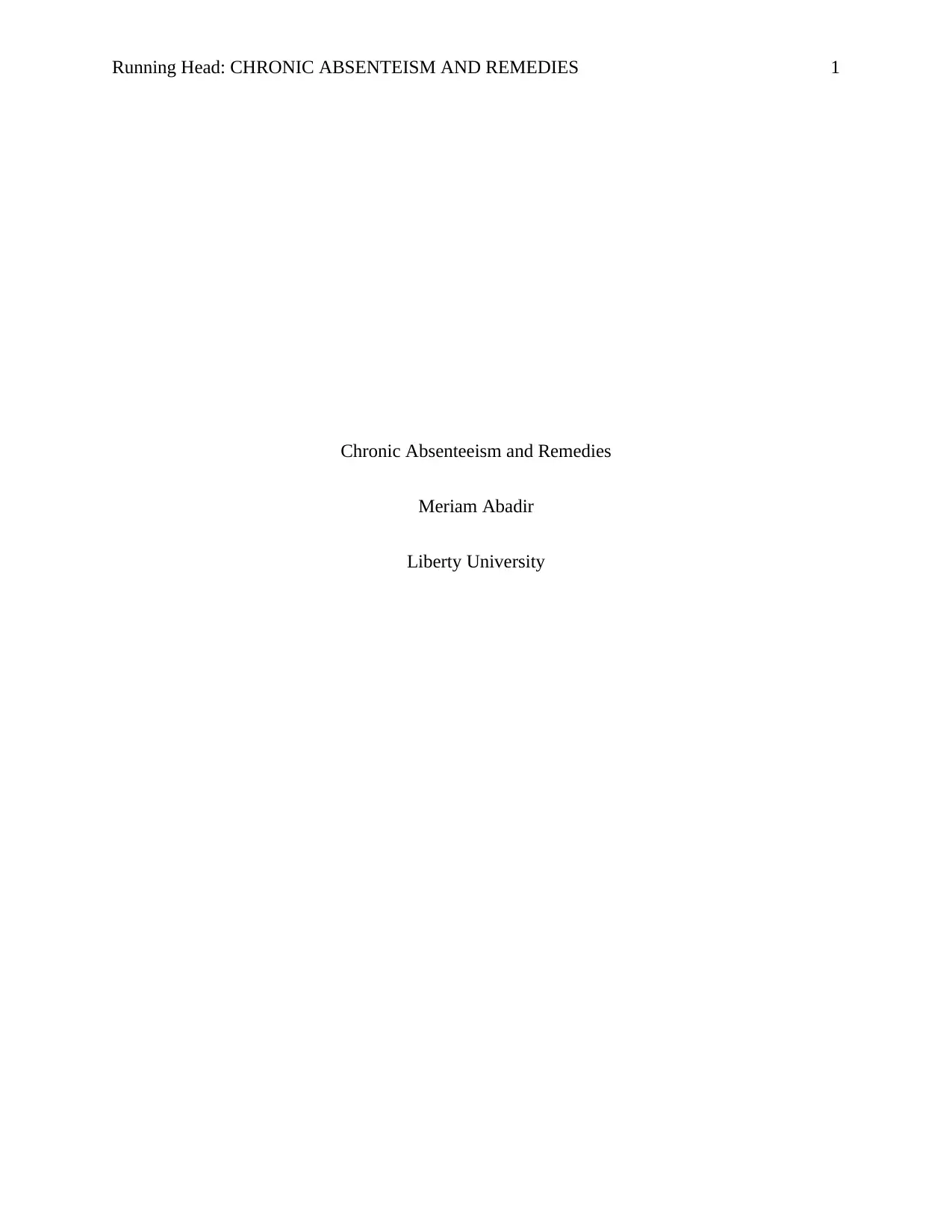
Running Head: CHRONIC ABSENTEISM AND REMEDIES 1
Chronic Absenteeism and Remedies
Meriam Abadir
Liberty University
Chronic Absenteeism and Remedies
Meriam Abadir
Liberty University
Paraphrase This Document
Need a fresh take? Get an instant paraphrase of this document with our AI Paraphraser
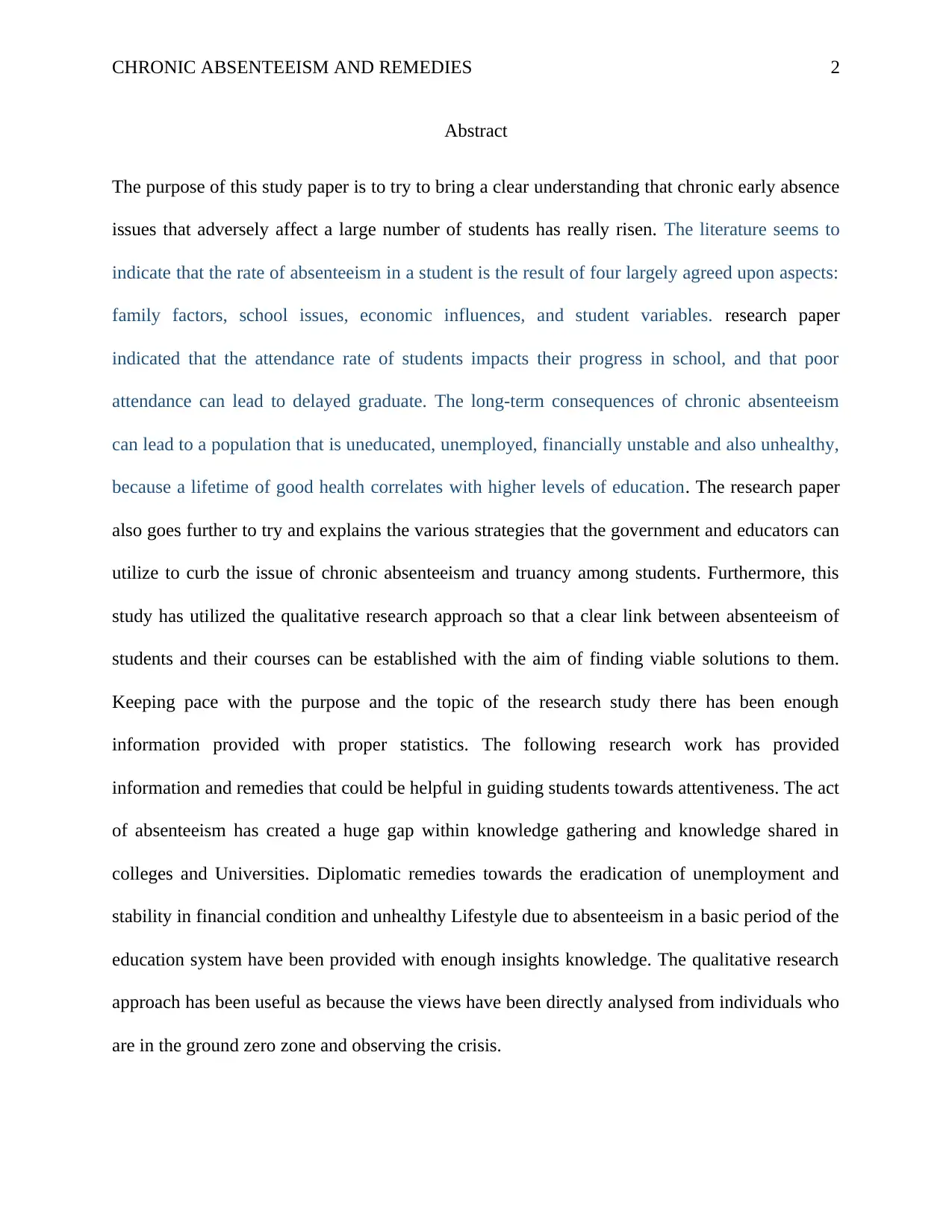
CHRONIC ABSENTEEISM AND REMEDIES 2
Abstract
The purpose of this study paper is to try to bring a clear understanding that chronic early absence
issues that adversely affect a large number of students has really risen. The literature seems to
indicate that the rate of absenteeism in a student is the result of four largely agreed upon aspects:
family factors, school issues, economic influences, and student variables. research paper
indicated that the attendance rate of students impacts their progress in school, and that poor
attendance can lead to delayed graduate. The long-term consequences of chronic absenteeism
can lead to a population that is uneducated, unemployed, financially unstable and also unhealthy,
because a lifetime of good health correlates with higher levels of education. The research paper
also goes further to try and explains the various strategies that the government and educators can
utilize to curb the issue of chronic absenteeism and truancy among students. Furthermore, this
study has utilized the qualitative research approach so that a clear link between absenteeism of
students and their courses can be established with the aim of finding viable solutions to them.
Keeping pace with the purpose and the topic of the research study there has been enough
information provided with proper statistics. The following research work has provided
information and remedies that could be helpful in guiding students towards attentiveness. The act
of absenteeism has created a huge gap within knowledge gathering and knowledge shared in
colleges and Universities. Diplomatic remedies towards the eradication of unemployment and
stability in financial condition and unhealthy Lifestyle due to absenteeism in a basic period of the
education system have been provided with enough insights knowledge. The qualitative research
approach has been useful as because the views have been directly analysed from individuals who
are in the ground zero zone and observing the crisis.
Abstract
The purpose of this study paper is to try to bring a clear understanding that chronic early absence
issues that adversely affect a large number of students has really risen. The literature seems to
indicate that the rate of absenteeism in a student is the result of four largely agreed upon aspects:
family factors, school issues, economic influences, and student variables. research paper
indicated that the attendance rate of students impacts their progress in school, and that poor
attendance can lead to delayed graduate. The long-term consequences of chronic absenteeism
can lead to a population that is uneducated, unemployed, financially unstable and also unhealthy,
because a lifetime of good health correlates with higher levels of education. The research paper
also goes further to try and explains the various strategies that the government and educators can
utilize to curb the issue of chronic absenteeism and truancy among students. Furthermore, this
study has utilized the qualitative research approach so that a clear link between absenteeism of
students and their courses can be established with the aim of finding viable solutions to them.
Keeping pace with the purpose and the topic of the research study there has been enough
information provided with proper statistics. The following research work has provided
information and remedies that could be helpful in guiding students towards attentiveness. The act
of absenteeism has created a huge gap within knowledge gathering and knowledge shared in
colleges and Universities. Diplomatic remedies towards the eradication of unemployment and
stability in financial condition and unhealthy Lifestyle due to absenteeism in a basic period of the
education system have been provided with enough insights knowledge. The qualitative research
approach has been useful as because the views have been directly analysed from individuals who
are in the ground zero zone and observing the crisis.
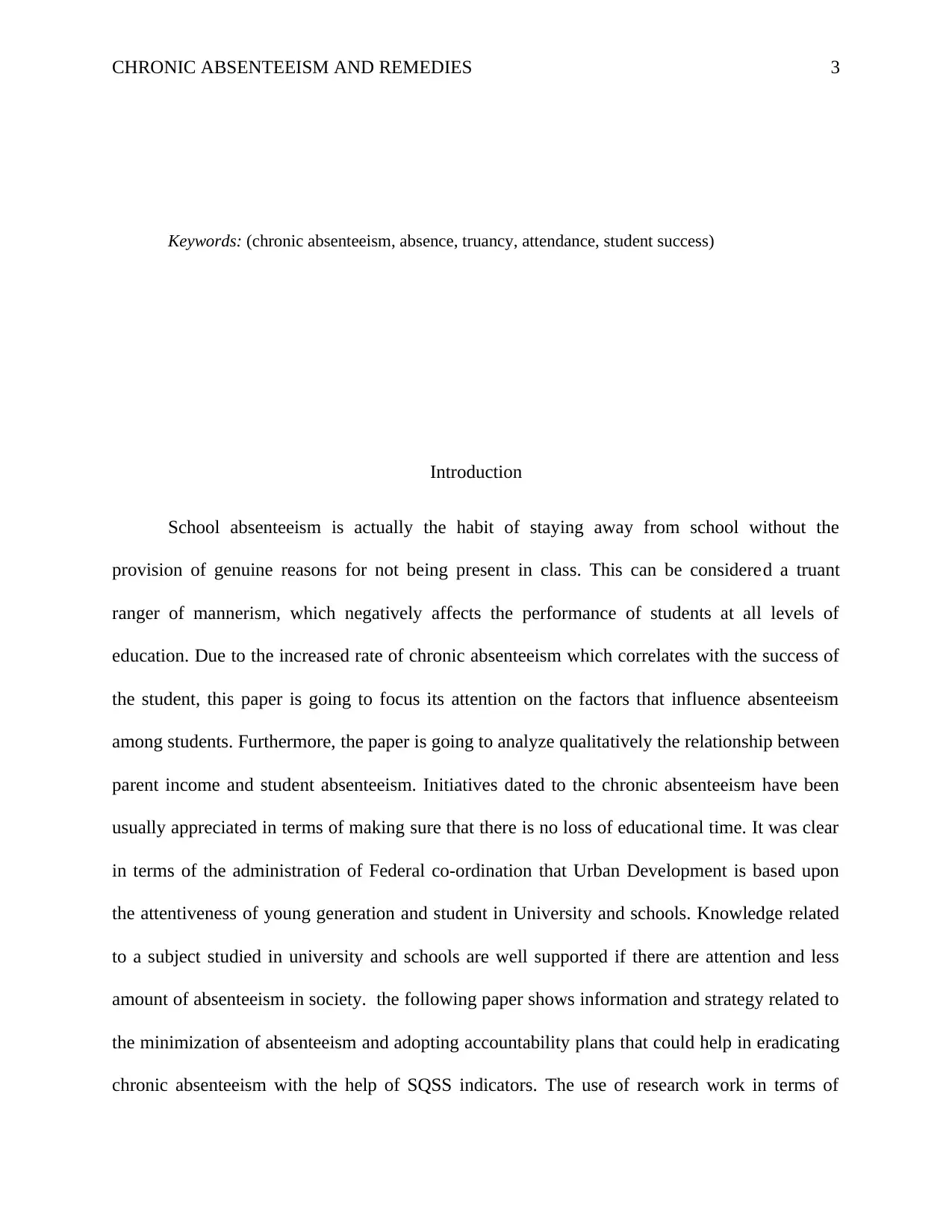
CHRONIC ABSENTEEISM AND REMEDIES 3
Keywords: (chronic absenteeism, absence, truancy, attendance, student success)
Introduction
School absenteeism is actually the habit of staying away from school without the
provision of genuine reasons for not being present in class. This can be considered a truant
ranger of mannerism, which negatively affects the performance of students at all levels of
education. Due to the increased rate of chronic absenteeism which correlates with the success of
the student, this paper is going to focus its attention on the factors that influence absenteeism
among students. Furthermore, the paper is going to analyze qualitatively the relationship between
parent income and student absenteeism. Initiatives dated to the chronic absenteeism have been
usually appreciated in terms of making sure that there is no loss of educational time. It was clear
in terms of the administration of Federal co-ordination that Urban Development is based upon
the attentiveness of young generation and student in University and schools. Knowledge related
to a subject studied in university and schools are well supported if there are attention and less
amount of absenteeism in society. the following paper shows information and strategy related to
the minimization of absenteeism and adopting accountability plans that could help in eradicating
chronic absenteeism with the help of SQSS indicators. The use of research work in terms of
Keywords: (chronic absenteeism, absence, truancy, attendance, student success)
Introduction
School absenteeism is actually the habit of staying away from school without the
provision of genuine reasons for not being present in class. This can be considered a truant
ranger of mannerism, which negatively affects the performance of students at all levels of
education. Due to the increased rate of chronic absenteeism which correlates with the success of
the student, this paper is going to focus its attention on the factors that influence absenteeism
among students. Furthermore, the paper is going to analyze qualitatively the relationship between
parent income and student absenteeism. Initiatives dated to the chronic absenteeism have been
usually appreciated in terms of making sure that there is no loss of educational time. It was clear
in terms of the administration of Federal co-ordination that Urban Development is based upon
the attentiveness of young generation and student in University and schools. Knowledge related
to a subject studied in university and schools are well supported if there are attention and less
amount of absenteeism in society. the following paper shows information and strategy related to
the minimization of absenteeism and adopting accountability plans that could help in eradicating
chronic absenteeism with the help of SQSS indicators. The use of research work in terms of
⊘ This is a preview!⊘
Do you want full access?
Subscribe today to unlock all pages.

Trusted by 1+ million students worldwide
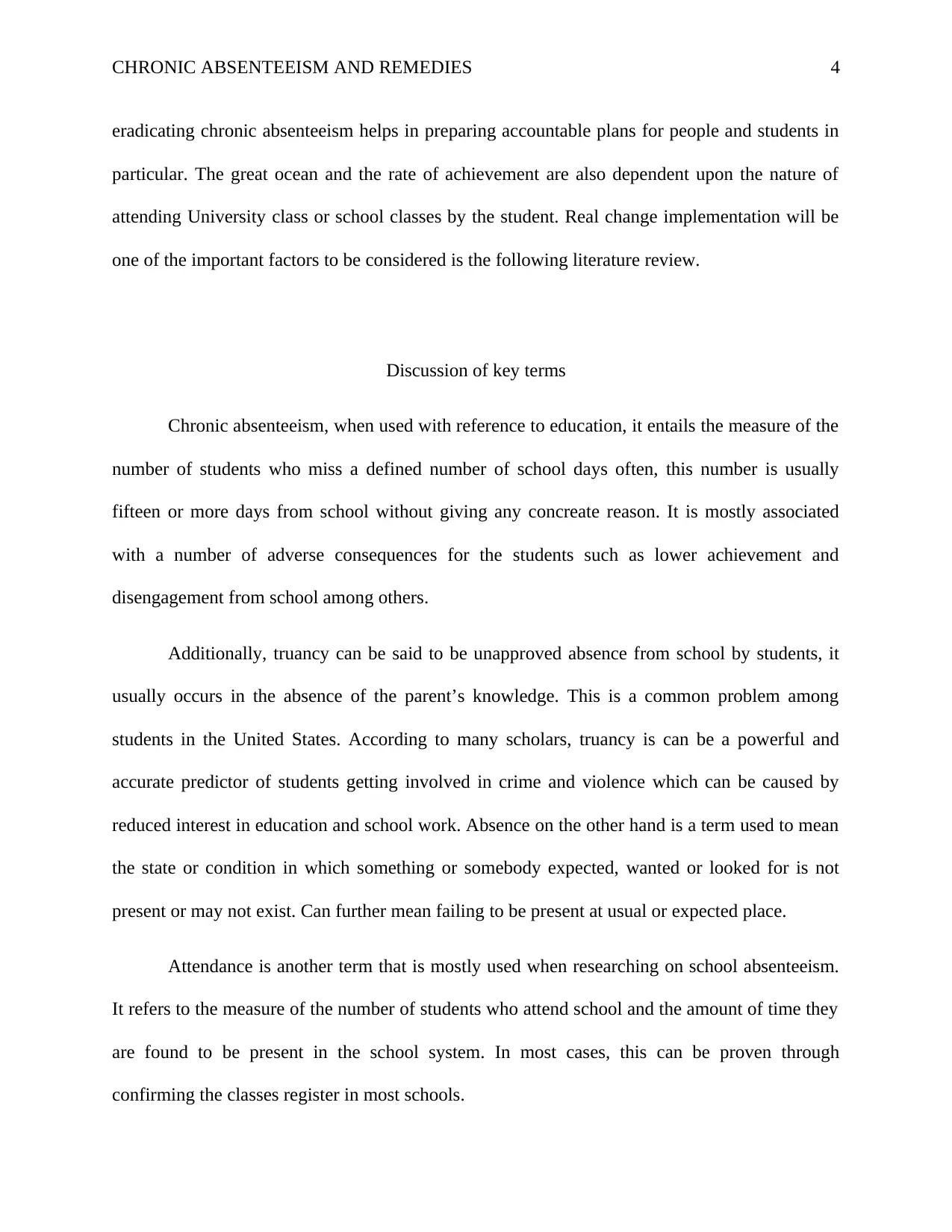
CHRONIC ABSENTEEISM AND REMEDIES 4
eradicating chronic absenteeism helps in preparing accountable plans for people and students in
particular. The great ocean and the rate of achievement are also dependent upon the nature of
attending University class or school classes by the student. Real change implementation will be
one of the important factors to be considered is the following literature review.
Discussion of key terms
Chronic absenteeism, when used with reference to education, it entails the measure of the
number of students who miss a defined number of school days often, this number is usually
fifteen or more days from school without giving any concreate reason. It is mostly associated
with a number of adverse consequences for the students such as lower achievement and
disengagement from school among others.
Additionally, truancy can be said to be unapproved absence from school by students, it
usually occurs in the absence of the parent’s knowledge. This is a common problem among
students in the United States. According to many scholars, truancy is can be a powerful and
accurate predictor of students getting involved in crime and violence which can be caused by
reduced interest in education and school work. Absence on the other hand is a term used to mean
the state or condition in which something or somebody expected, wanted or looked for is not
present or may not exist. Can further mean failing to be present at usual or expected place.
Attendance is another term that is mostly used when researching on school absenteeism.
It refers to the measure of the number of students who attend school and the amount of time they
are found to be present in the school system. In most cases, this can be proven through
confirming the classes register in most schools.
eradicating chronic absenteeism helps in preparing accountable plans for people and students in
particular. The great ocean and the rate of achievement are also dependent upon the nature of
attending University class or school classes by the student. Real change implementation will be
one of the important factors to be considered is the following literature review.
Discussion of key terms
Chronic absenteeism, when used with reference to education, it entails the measure of the
number of students who miss a defined number of school days often, this number is usually
fifteen or more days from school without giving any concreate reason. It is mostly associated
with a number of adverse consequences for the students such as lower achievement and
disengagement from school among others.
Additionally, truancy can be said to be unapproved absence from school by students, it
usually occurs in the absence of the parent’s knowledge. This is a common problem among
students in the United States. According to many scholars, truancy is can be a powerful and
accurate predictor of students getting involved in crime and violence which can be caused by
reduced interest in education and school work. Absence on the other hand is a term used to mean
the state or condition in which something or somebody expected, wanted or looked for is not
present or may not exist. Can further mean failing to be present at usual or expected place.
Attendance is another term that is mostly used when researching on school absenteeism.
It refers to the measure of the number of students who attend school and the amount of time they
are found to be present in the school system. In most cases, this can be proven through
confirming the classes register in most schools.
Paraphrase This Document
Need a fresh take? Get an instant paraphrase of this document with our AI Paraphraser
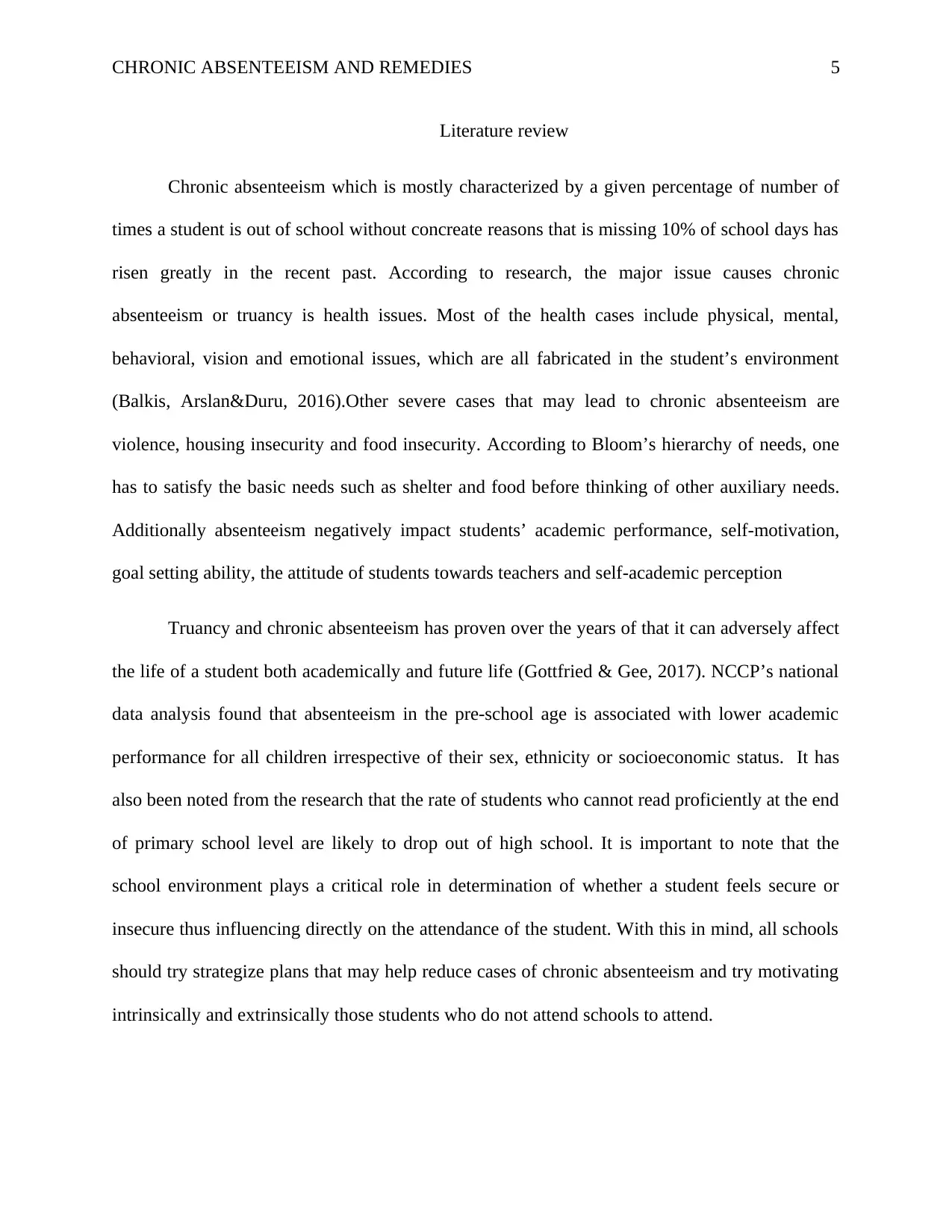
CHRONIC ABSENTEEISM AND REMEDIES 5
Literature review
Chronic absenteeism which is mostly characterized by a given percentage of number of
times a student is out of school without concreate reasons that is missing 10% of school days has
risen greatly in the recent past. According to research, the major issue causes chronic
absenteeism or truancy is health issues. Most of the health cases include physical, mental,
behavioral, vision and emotional issues, which are all fabricated in the student’s environment
(Balkis, Arslan&Duru, 2016).Other severe cases that may lead to chronic absenteeism are
violence, housing insecurity and food insecurity. According to Bloom’s hierarchy of needs, one
has to satisfy the basic needs such as shelter and food before thinking of other auxiliary needs.
Additionally absenteeism negatively impact students’ academic performance, self-motivation,
goal setting ability, the attitude of students towards teachers and self-academic perception
Truancy and chronic absenteeism has proven over the years of that it can adversely affect
the life of a student both academically and future life (Gottfried & Gee, 2017). NCCP’s national
data analysis found that absenteeism in the pre-school age is associated with lower academic
performance for all children irrespective of their sex, ethnicity or socioeconomic status. It has
also been noted from the research that the rate of students who cannot read proficiently at the end
of primary school level are likely to drop out of high school. It is important to note that the
school environment plays a critical role in determination of whether a student feels secure or
insecure thus influencing directly on the attendance of the student. With this in mind, all schools
should try strategize plans that may help reduce cases of chronic absenteeism and try motivating
intrinsically and extrinsically those students who do not attend schools to attend.
Literature review
Chronic absenteeism which is mostly characterized by a given percentage of number of
times a student is out of school without concreate reasons that is missing 10% of school days has
risen greatly in the recent past. According to research, the major issue causes chronic
absenteeism or truancy is health issues. Most of the health cases include physical, mental,
behavioral, vision and emotional issues, which are all fabricated in the student’s environment
(Balkis, Arslan&Duru, 2016).Other severe cases that may lead to chronic absenteeism are
violence, housing insecurity and food insecurity. According to Bloom’s hierarchy of needs, one
has to satisfy the basic needs such as shelter and food before thinking of other auxiliary needs.
Additionally absenteeism negatively impact students’ academic performance, self-motivation,
goal setting ability, the attitude of students towards teachers and self-academic perception
Truancy and chronic absenteeism has proven over the years of that it can adversely affect
the life of a student both academically and future life (Gottfried & Gee, 2017). NCCP’s national
data analysis found that absenteeism in the pre-school age is associated with lower academic
performance for all children irrespective of their sex, ethnicity or socioeconomic status. It has
also been noted from the research that the rate of students who cannot read proficiently at the end
of primary school level are likely to drop out of high school. It is important to note that the
school environment plays a critical role in determination of whether a student feels secure or
insecure thus influencing directly on the attendance of the student. With this in mind, all schools
should try strategize plans that may help reduce cases of chronic absenteeism and try motivating
intrinsically and extrinsically those students who do not attend schools to attend.
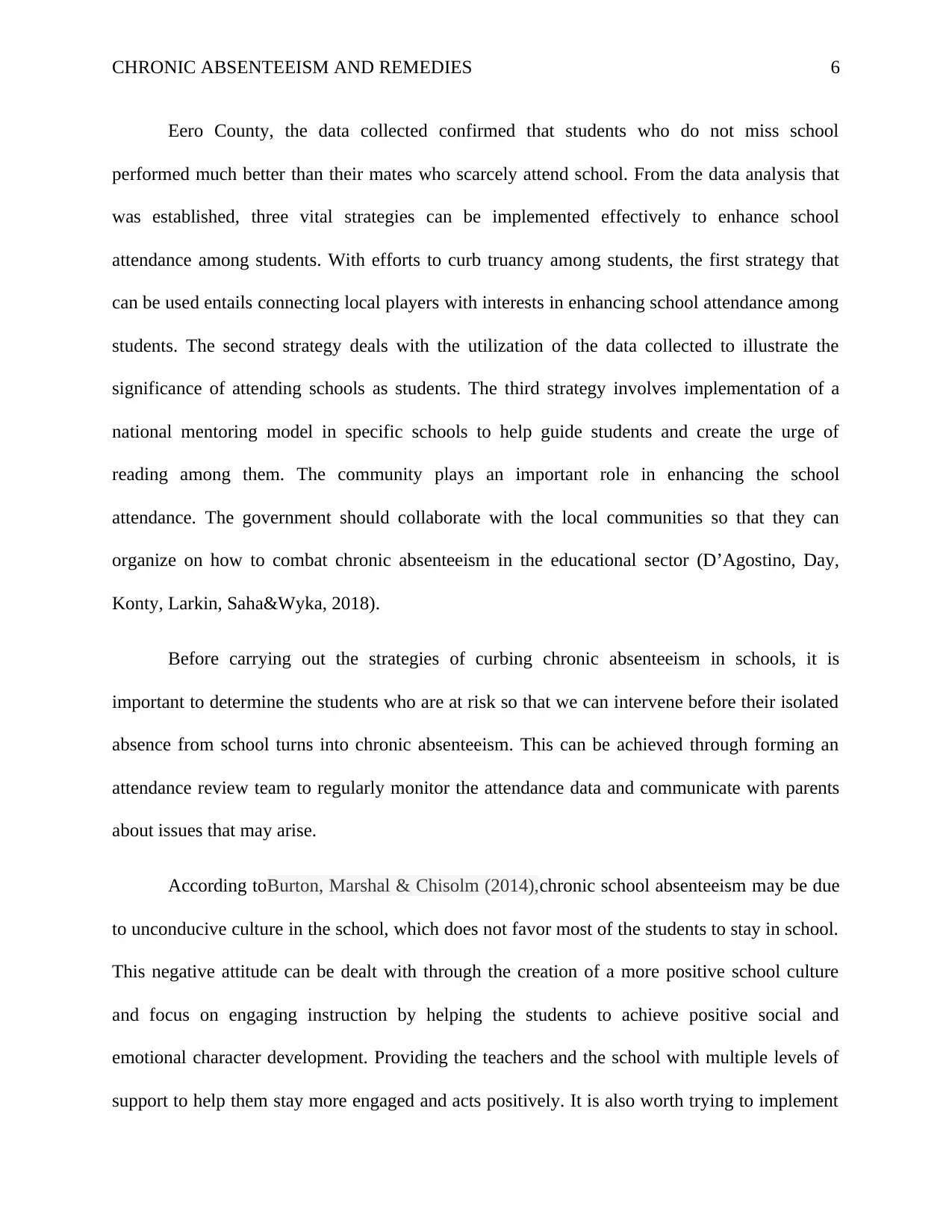
CHRONIC ABSENTEEISM AND REMEDIES 6
Eero County, the data collected confirmed that students who do not miss school
performed much better than their mates who scarcely attend school. From the data analysis that
was established, three vital strategies can be implemented effectively to enhance school
attendance among students. With efforts to curb truancy among students, the first strategy that
can be used entails connecting local players with interests in enhancing school attendance among
students. The second strategy deals with the utilization of the data collected to illustrate the
significance of attending schools as students. The third strategy involves implementation of a
national mentoring model in specific schools to help guide students and create the urge of
reading among them. The community plays an important role in enhancing the school
attendance. The government should collaborate with the local communities so that they can
organize on how to combat chronic absenteeism in the educational sector (D’Agostino, Day,
Konty, Larkin, Saha&Wyka, 2018).
Before carrying out the strategies of curbing chronic absenteeism in schools, it is
important to determine the students who are at risk so that we can intervene before their isolated
absence from school turns into chronic absenteeism. This can be achieved through forming an
attendance review team to regularly monitor the attendance data and communicate with parents
about issues that may arise.
According toBurton, Marshal & Chisolm (2014),chronic school absenteeism may be due
to unconducive culture in the school, which does not favor most of the students to stay in school.
This negative attitude can be dealt with through the creation of a more positive school culture
and focus on engaging instruction by helping the students to achieve positive social and
emotional character development. Providing the teachers and the school with multiple levels of
support to help them stay more engaged and acts positively. It is also worth trying to implement
Eero County, the data collected confirmed that students who do not miss school
performed much better than their mates who scarcely attend school. From the data analysis that
was established, three vital strategies can be implemented effectively to enhance school
attendance among students. With efforts to curb truancy among students, the first strategy that
can be used entails connecting local players with interests in enhancing school attendance among
students. The second strategy deals with the utilization of the data collected to illustrate the
significance of attending schools as students. The third strategy involves implementation of a
national mentoring model in specific schools to help guide students and create the urge of
reading among them. The community plays an important role in enhancing the school
attendance. The government should collaborate with the local communities so that they can
organize on how to combat chronic absenteeism in the educational sector (D’Agostino, Day,
Konty, Larkin, Saha&Wyka, 2018).
Before carrying out the strategies of curbing chronic absenteeism in schools, it is
important to determine the students who are at risk so that we can intervene before their isolated
absence from school turns into chronic absenteeism. This can be achieved through forming an
attendance review team to regularly monitor the attendance data and communicate with parents
about issues that may arise.
According toBurton, Marshal & Chisolm (2014),chronic school absenteeism may be due
to unconducive culture in the school, which does not favor most of the students to stay in school.
This negative attitude can be dealt with through the creation of a more positive school culture
and focus on engaging instruction by helping the students to achieve positive social and
emotional character development. Providing the teachers and the school with multiple levels of
support to help them stay more engaged and acts positively. It is also worth trying to implement
⊘ This is a preview!⊘
Do you want full access?
Subscribe today to unlock all pages.

Trusted by 1+ million students worldwide
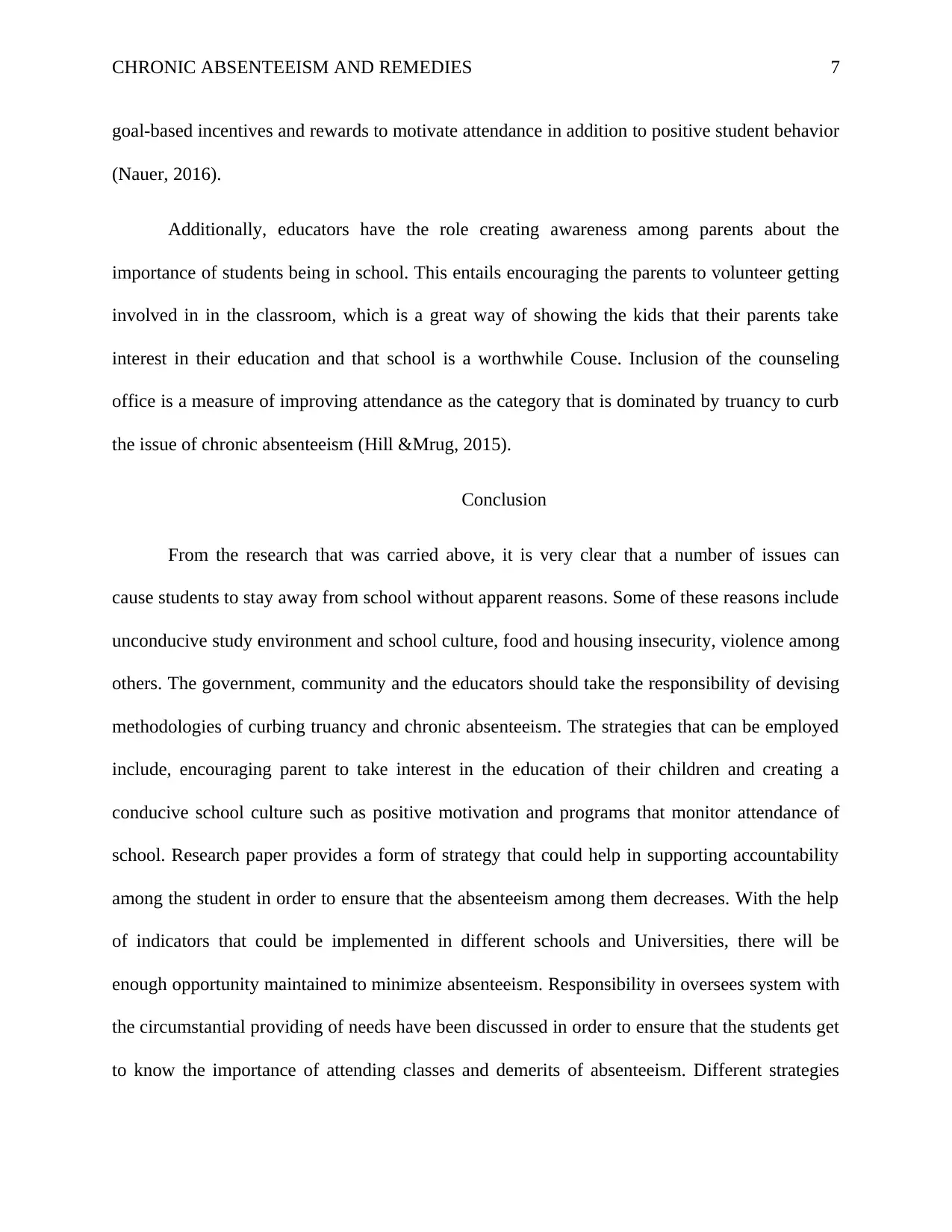
CHRONIC ABSENTEEISM AND REMEDIES 7
goal-based incentives and rewards to motivate attendance in addition to positive student behavior
(Nauer, 2016).
Additionally, educators have the role creating awareness among parents about the
importance of students being in school. This entails encouraging the parents to volunteer getting
involved in in the classroom, which is a great way of showing the kids that their parents take
interest in their education and that school is a worthwhile Couse. Inclusion of the counseling
office is a measure of improving attendance as the category that is dominated by truancy to curb
the issue of chronic absenteeism (Hill &Mrug, 2015).
Conclusion
From the research that was carried above, it is very clear that a number of issues can
cause students to stay away from school without apparent reasons. Some of these reasons include
unconducive study environment and school culture, food and housing insecurity, violence among
others. The government, community and the educators should take the responsibility of devising
methodologies of curbing truancy and chronic absenteeism. The strategies that can be employed
include, encouraging parent to take interest in the education of their children and creating a
conducive school culture such as positive motivation and programs that monitor attendance of
school. Research paper provides a form of strategy that could help in supporting accountability
among the student in order to ensure that the absenteeism among them decreases. With the help
of indicators that could be implemented in different schools and Universities, there will be
enough opportunity maintained to minimize absenteeism. Responsibility in oversees system with
the circumstantial providing of needs have been discussed in order to ensure that the students get
to know the importance of attending classes and demerits of absenteeism. Different strategies
goal-based incentives and rewards to motivate attendance in addition to positive student behavior
(Nauer, 2016).
Additionally, educators have the role creating awareness among parents about the
importance of students being in school. This entails encouraging the parents to volunteer getting
involved in in the classroom, which is a great way of showing the kids that their parents take
interest in their education and that school is a worthwhile Couse. Inclusion of the counseling
office is a measure of improving attendance as the category that is dominated by truancy to curb
the issue of chronic absenteeism (Hill &Mrug, 2015).
Conclusion
From the research that was carried above, it is very clear that a number of issues can
cause students to stay away from school without apparent reasons. Some of these reasons include
unconducive study environment and school culture, food and housing insecurity, violence among
others. The government, community and the educators should take the responsibility of devising
methodologies of curbing truancy and chronic absenteeism. The strategies that can be employed
include, encouraging parent to take interest in the education of their children and creating a
conducive school culture such as positive motivation and programs that monitor attendance of
school. Research paper provides a form of strategy that could help in supporting accountability
among the student in order to ensure that the absenteeism among them decreases. With the help
of indicators that could be implemented in different schools and Universities, there will be
enough opportunity maintained to minimize absenteeism. Responsibility in oversees system with
the circumstantial providing of needs have been discussed in order to ensure that the students get
to know the importance of attending classes and demerits of absenteeism. Different strategies
Paraphrase This Document
Need a fresh take? Get an instant paraphrase of this document with our AI Paraphraser
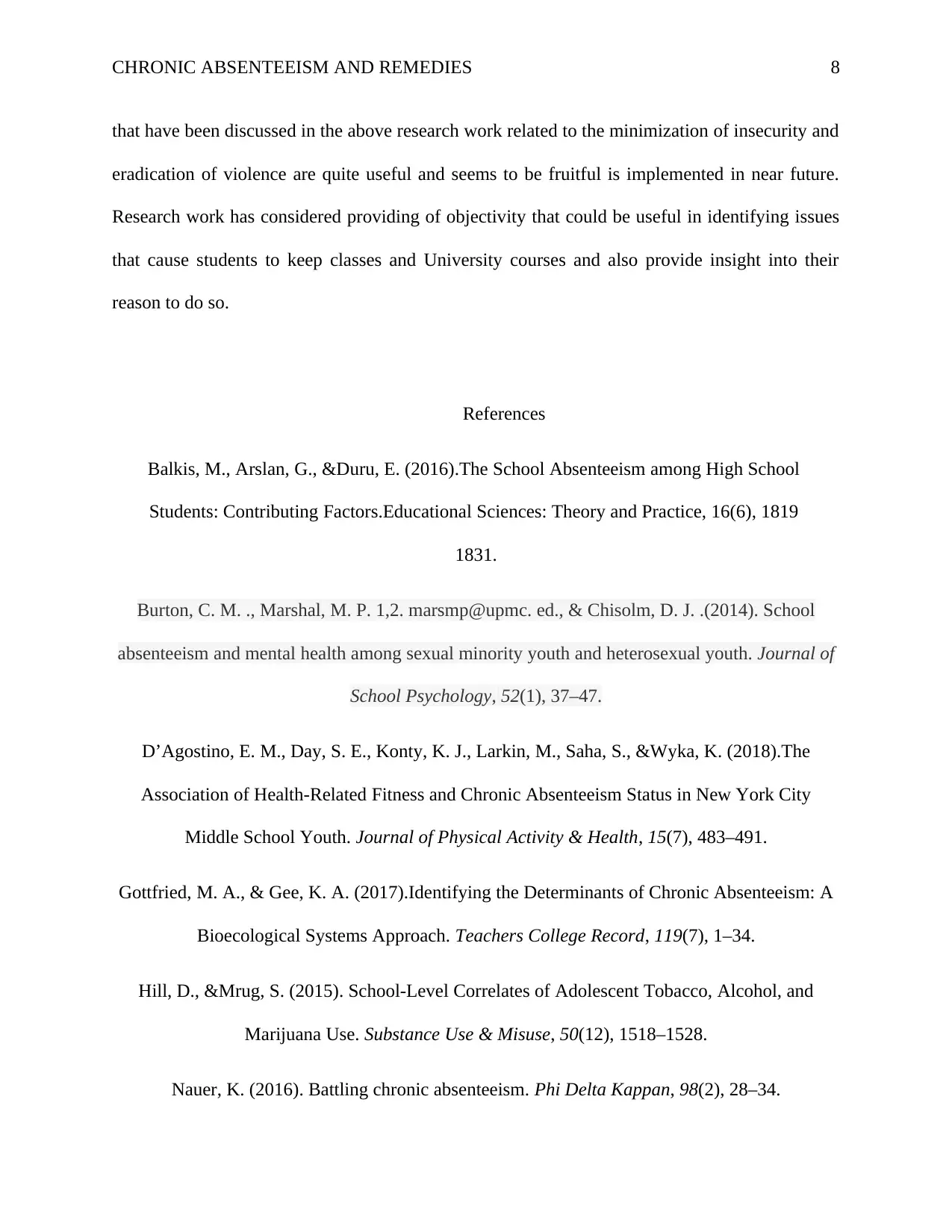
CHRONIC ABSENTEEISM AND REMEDIES 8
that have been discussed in the above research work related to the minimization of insecurity and
eradication of violence are quite useful and seems to be fruitful is implemented in near future.
Research work has considered providing of objectivity that could be useful in identifying issues
that cause students to keep classes and University courses and also provide insight into their
reason to do so.
References
Balkis, M., Arslan, G., &Duru, E. (2016).The School Absenteeism among High School
Students: Contributing Factors.Educational Sciences: Theory and Practice, 16(6), 1819
1831.
Burton, C. M. ., Marshal, M. P. 1,2. marsmp@upmc. ed., & Chisolm, D. J. .(2014). School
absenteeism and mental health among sexual minority youth and heterosexual youth. Journal of
School Psychology, 52(1), 37–47.
D’Agostino, E. M., Day, S. E., Konty, K. J., Larkin, M., Saha, S., &Wyka, K. (2018).The
Association of Health-Related Fitness and Chronic Absenteeism Status in New York City
Middle School Youth. Journal of Physical Activity & Health, 15(7), 483–491.
Gottfried, M. A., & Gee, K. A. (2017).Identifying the Determinants of Chronic Absenteeism: A
Bioecological Systems Approach. Teachers College Record, 119(7), 1–34.
Hill, D., &Mrug, S. (2015). School-Level Correlates of Adolescent Tobacco, Alcohol, and
Marijuana Use. Substance Use & Misuse, 50(12), 1518–1528.
Nauer, K. (2016). Battling chronic absenteeism. Phi Delta Kappan, 98(2), 28–34.
that have been discussed in the above research work related to the minimization of insecurity and
eradication of violence are quite useful and seems to be fruitful is implemented in near future.
Research work has considered providing of objectivity that could be useful in identifying issues
that cause students to keep classes and University courses and also provide insight into their
reason to do so.
References
Balkis, M., Arslan, G., &Duru, E. (2016).The School Absenteeism among High School
Students: Contributing Factors.Educational Sciences: Theory and Practice, 16(6), 1819
1831.
Burton, C. M. ., Marshal, M. P. 1,2. marsmp@upmc. ed., & Chisolm, D. J. .(2014). School
absenteeism and mental health among sexual minority youth and heterosexual youth. Journal of
School Psychology, 52(1), 37–47.
D’Agostino, E. M., Day, S. E., Konty, K. J., Larkin, M., Saha, S., &Wyka, K. (2018).The
Association of Health-Related Fitness and Chronic Absenteeism Status in New York City
Middle School Youth. Journal of Physical Activity & Health, 15(7), 483–491.
Gottfried, M. A., & Gee, K. A. (2017).Identifying the Determinants of Chronic Absenteeism: A
Bioecological Systems Approach. Teachers College Record, 119(7), 1–34.
Hill, D., &Mrug, S. (2015). School-Level Correlates of Adolescent Tobacco, Alcohol, and
Marijuana Use. Substance Use & Misuse, 50(12), 1518–1528.
Nauer, K. (2016). Battling chronic absenteeism. Phi Delta Kappan, 98(2), 28–34.

CHRONIC ABSENTEEISM AND REMEDIES 9
⊘ This is a preview!⊘
Do you want full access?
Subscribe today to unlock all pages.

Trusted by 1+ million students worldwide
1 out of 9
Related Documents
Your All-in-One AI-Powered Toolkit for Academic Success.
+13062052269
info@desklib.com
Available 24*7 on WhatsApp / Email
![[object Object]](/_next/static/media/star-bottom.7253800d.svg)
Unlock your academic potential
Copyright © 2020–2025 A2Z Services. All Rights Reserved. Developed and managed by ZUCOL.





